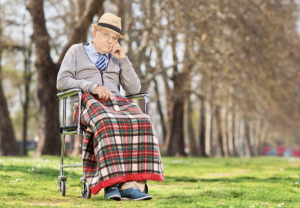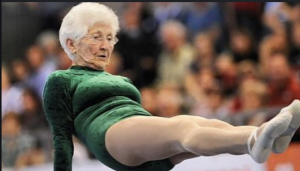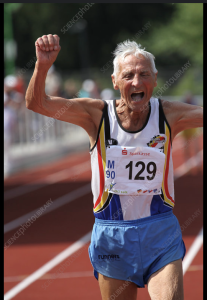6
Section One: The Fundamentals
A) Keywords
Exercise 1:
Provide a brief definition of one of the padlet keywords for this week.
| Third age: or the period of life in which you have been able to retire or significantly decrease work load, you are generally healthy and can remain active. In this stage people are often recreating themselves rather than withdrawing from life. The ability to continue to be active and take part in sport and activity through alternative means. Pike also explains the evolving number of people in this category as we continue to live to older ages. |
B) The Social Significance of Aging in Sport
Exercise 2: Notebook Prompt
How is old age popularly represented today? Find an image online that you think exemplifies one defining attitude towards old age and paste in your notebook below with a brief explanation of what this image means to you.

The stereotypical perspective of old age is becoming sedentary becoming weak and senile. The image of an older person locked in a chair unable to escape it. |
Exercise 3: Notebook Prompt
What does the article (referencing another study by Dionigi) mean by its statement that sport can help aging people to simultaneously “accept and resist the ageing process” (572)? Respond by audio or text and find paste two images sourced online into your notebook showing how sport might help aging people to both accept and resist the aging process.
|
Sport can help aging people simultaneously accept and resist the aging process by providing an avenue to to challenge their bodies within various sports. The acceptance of a changing body does not mean that the sports they loved are over rather that they must be approached in new ways. This continuation of sport into older ages as such resists the typical process of aging instead giving back the power of a healthy body.
|
Exercise 4: Notebook Prompt
Who are the groups less likely to have extensive opportunities to take part in sports, according to Pike? How does privilege factor into aging and sport? (200 words max)
|
According to Pike those who are more frail, and minority groups such as those with disabilities and some ethnic groups, those living in rural areas, and those institutionalized will be less likely to have extensive opportunities to take part in sports. Sports at all ages are a luxury when they should be essential. The ability to foster healthy lifestyles and create social opportunities is important at all ages for all people. The ability to afford high end retirement communities and membership fees becomes more essential to remain in sport as you age. There is no longer the school system and funding that is geared towards the healthy child. I have had the opportunity to work within a variety of retirement homes. There is a vast difference in the wellness opportunities between those who can afford to stay in more elite luxury living than those who are in housing geared to income. The pickle ball courts, pools, square dancing instructors, and so on are only found within one of these. The ability to afford sports is a major inhibiting factor across the life span. |
Exercise 5: Padlet Discussion
Why do you think age discrimination is “reported more than any form of prejudice” with older people presented as a threat to social values and interests? Feel welcome to use video in your responses. Paste your comments (or transcript of your video) below!
|
I think that agism is so common that it is seen as normal in many aspects. This would lead to being the most reported as unfortunately people do not see the issue in it anymore. It is an expected action rather than anything else. I think that there are even actions that are done in the idea of being kind for instance someone you perceive as being older is sitting in a chair and they are asked to get up or notice they are going to move, how many people grab them under their arm prior to waiting to see if they can first do it on their own? How many people wait to see if they even want or need your help?
|
B) Older Women and Sport
Exercise 6: Notebook Prompt
What differences do you see in these ads? Which one is more inclusive? How is age represented or not represented in each? Answer these questions in your notebook.
| The major difference between these two adds is that one focuses on women and the entire age span while the other is all gender but with a focus on a younger population. To say one is more inclusive over the other would be difficult as they are both lacking in some areas. |
Exercise 7: Notebook Prompt
In her article, “Assessing the sociology of sport: On age and ability,” Elizabeth Pike references a “trend towards a ‘feminisation of ageing’, with many women living longer than men” (573). Do you agree that aging has been “feminized” in this way? How? Answer these questions in your notebook.
| I suppose I agree that aging has been feminized in this way, however this concept is not new. Women have notoriously lived longer than men. There are several factors that have been reviewed over time including women tend to not live as precarious of lifestyles, and tend to take better care of their bodies. There is also evidence to show that men pass away from the “widow effect” or broken heart syndrome more often than women do.
|
Section Three: Module Mini Assignment
|
Pickle-ball is played by many of all ages. The rules are easy to learn and as such even beginners can have great success. The low impact sport provides an avenue to maintain activity levels and provides an excellent space for social interaction. These benefits while exceptional for all rank even higher for older adults. Pike reviews some of the misconceptions around older adults and activity including how they can be seen as frail and avoiding activities such as sport would be advised (Pike, 2015). These are challenged with the need to keep active and engaged as to avoid decline requiring more and more assistance as we age (Pike, 2015). The game of pickle ball does seem to provide the ability to engage and compete in social setting amongst peers. The fascinating part about it is that there is not many other sorts out there that are truly intergenerational. The ability to be schooled in a sport by someone twice your age that is not also a professional is something to marvel at. The increased prevalence within many local communities shows that they in fact do continue to challenge how sports are organized and work to alter that perception of the elderly in sport(Pike, 2015). Reference Pike, E. C. (2015). Assessing the sociology of sport: On age and ability. International Review for the Sociology of Sport, 50(4–5), 570–574. https://doi.org/10.1177/1012690214550009
|



